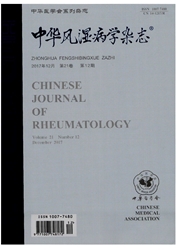

 中文摘要:
中文摘要:
目的建立Cryopyrin相关周期热综合征(CAPS)分子遗传诊断方法,并应用于临床诊断。方法收集患者和对照外周血DNA,采用PCR方法扩增CAPS相关基因NLRP3(NOD样受体家族,含有pyrin功能域蛋白3)的9个外显子并测序,通过与该基因外显子的参考序列进行比对,进行序列分析,寻找突变位点。收集患者临床资料,并对相关文献进行综述。结果成功建立CAPS相关基因NLRP3的外显子测序方法,并采用该方法发现1例患者NLRP3基因存在非同义突变[D303N:即第303位氨基酸从天冬氨酸(D)突变为天冬酰氨(N)],结合患者临床症状、体征,诊断为慢性婴儿神经皮肤关节综合征(CINCA)。结论NLRP3基因分子遗传检测方法的建立有利于CAPS的诊断和研究。
 英文摘要:
英文摘要:
Objective To setup a pla[form for genetic diagnosis of Cryopyrin associated periodic syndrome (CAPS) and to use it for clinical diagnosis. Methods The peripheral blood cells of the patient and the controls were collected for DNA extraction. Nine exons of CAPS associated gene NLRP3 were amplified using polymerase chain reaction (PCR) and subjected to sequencing. Blast was used to compare the seque- ncing results with the reference gene and to locate mutation. The clinical information of the patient was collected and the relevant literature was reviewed. Results We set up a platform for exon sequencing of NLRP3 gene. Using this platform, we identified a nonsynonymous mutation in a female patient (D303N, aspartic acid at locus 303 mutated to asparagine). Considering the clinical manifestations of the patient, chronic infantile neurologic cutaneous and articular syndrome (CINCA) was diagnosed. Conclusion The set up of the platform for NLRP3 genetic analysis will facilitate the clinical awareness and research on CAPS.
 同期刊论文项目
同期刊论文项目
 同项目期刊论文
同项目期刊论文
 期刊信息
期刊信息
